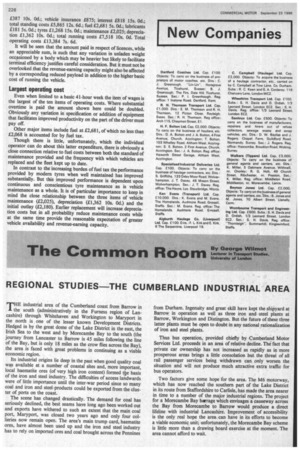REGIONAL STUDIES THE CUMBERLAND INDUSTRIAL AREA
Page 252

If you've noticed an error in this article please click here to report it so we can fix it.
THE industrial area of the Cumberland coast from Barrow in the south (administratively in the Furness region of Lancashire) through Whitehaven and Workington to Maryport in the north is one of the lesser known Development Districts. Hedged in by the great dome of the Lake District in the east, the Irish Sea to the west and by Morecambe Bay to the south (the journey from Lancaster to Barrow is 45 miles following the line of the Bay, but is only 18 miles as the crow flies across the Bay), the area is faced with great problems in continuing as a viable economic region.
Its industrial origins lie deep in the past when good quality coal was available at a number of coastal sites and, more important, local haematite ores (of very high iron content) formed tile basis of the iron and steel industry. The difficulties of access landwards were of little importance until the inter-war period since so many coal and iron and steel products could be exported from the cluster of ports on the coast.
The scene has changed drastically. The demand for coal has seriously declined, the best seams have long ago been worked out and exports have withered to such an extent that the main coal port, Maryport, was closed two years ago and only four collieries now remain open. The area's main trump card, haematite ores, have almost been used up and the iron and steel industry has to rely on imported ores and coal brought across the Pennines from Durham. Ingenuity and great skill have kept the shipyard at Barrow in operation as well as three iron and steel plants at Barrow, Workington and Distington. But the future of these three latter plants must be open to doubt in any national rationaliiation of iron and steel plants.
Thus bus operation, provided chiefly by Cumberland Motor Services Ltd. proceeds in an area of relative decline. The fact that private car ownership has not increased as rapidly as in more prosperous areas brings a little consolation but the threat of all rail passenger services being withdrawn can only worsen the situation and will not produce much attractive extra traffic for bus operators.
Two factors give some hope for the area. The M6 motorway, which has now reached the southern part of the Lake District in its route from Staffordshire to Carlisle, has made the area nearer in time to a number of the major industrial regions. The project for a Morecambe Bay barrage which envisages a causeway across the Bay from Morecambe to Barrow would produce a direct lifeline with industrial Lancashire. Improvement of accessibility is the only real hope the area can have in its efforts to become a viable economic unit; unfortunately, the Morecambe Bay scheme is little more than a drawing board exercise at the moment. The area cannot afford to wait.








































































































































































































































































































































































